Top Hosts Reports
WOCU-Monitoring’s Top Hosts reports are designed to identify the most relevant devices in an infrastructure based on their performance metrics. This feature allows you to generate customized and automated reports that analyze various technical parameters, such as RTT (rta), network traffic, CPU usage, memory usage, among others, providing a comparative view of the performance of the monitored assets.
Through these reports, users can see which devices have the highest,lowest, or average values for each metric over a defined time interval, facilitating early detection of anomalies, identification of bottlenecks, and analysis of performance trends.
The following details the process for creating and running reports, establishing a series of filters and parameters customized by the user.
Configuration and generation of Top Host Reports
Generally, when creating reports, the user should access the blue + Add button, located within the Reports section.

Before generating the report, you will need to configure a series of parameters described below:

Date range
This parameter establishes the time period for which the Availability calculation will be performed.
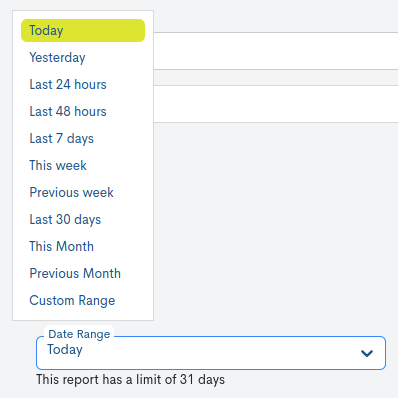
There are a number of time criteria already in place:
Parameter |
Description |
|---|---|
Today |
Filters and displays only data recorded during the time period that elapsed today. |
Yesterday |
Filters and displays only data recorded yesterday. |
Last 24 hours |
Filters and displays only data recorded in the last 24 hours. |
Last 48 hours |
Filters and displays only data recorded in the last 48 hours. |
Last 7 Days |
Filters and displays only data recorded in the last seven days. |
Last 30 Days |
Filters and displays only data recorded in the last thirty days. |
This Week |
Filters and displays only data recorded during the time period elapsed in the current week (from the start day of the week to the current day). |
Previous Week |
Filters and displays only data recorded in the previous full week (Monday to Sunday). |
Last 30 days |
Filters and displays only data recorded in the last 30 full days from the current date. |
This Month |
Filters and displays only data recorded during the time period elapsed in the current month (from day 1 to the current day of the month). |
Previous Month |
Filters and displays only data recorded in the previous full month (day 1 to days 28/30/31). |
If you want to define a specific time period, you can use the Custom Range option. To configure the time range, you must specify a start and end date. Clicking on a day will select it and highlight it with a blue background. In addition to the date, you can specify a specific time within that day using the drop-down menus for hours, minutes, and seconds, until you reach the exact moment you want. The selected date and time will be displayed in both the upper and lower boxes of the view.
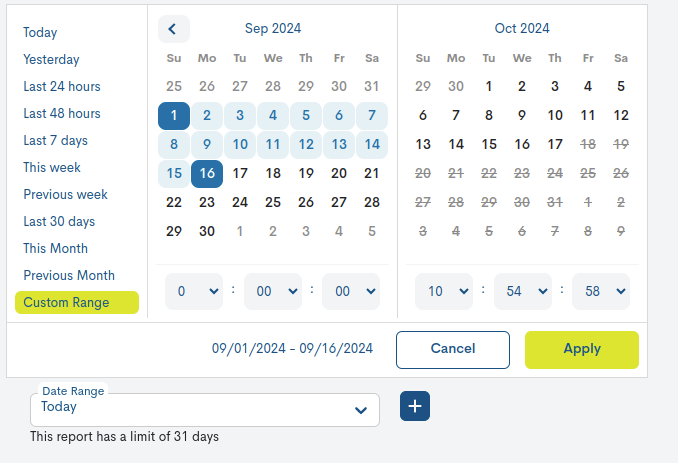
Using the plus sign (+) button, you can add multiple date ranges for data collection in the configured report. If you want to delete one, simply press the red button with the cross (X). The range will disappear, and when you run the report, only the remaining periods will be taken into account.
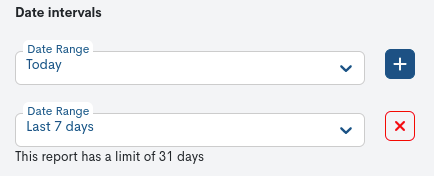
Attention
Logically, it is not possible to choose start and end dates later than the current date, or to set an end date earlier than the start date.
Name
Required field to record a report identifier term.
Report Template
In this optional field, the user can select the template they wish to apply to the report. Templates are pre-created and available for reuse during report configuration. More information can be found at: Templates.
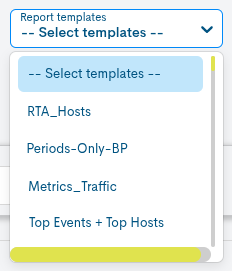
Report Covers
In this optional field, the user can choose a predefined cover for the report. This includes a cover image, a header on the pages, a main title, and a footnote. This gives documents a corporate and professional appearance, tailored to the organization’s visual identity. More information can be found at: Covers.
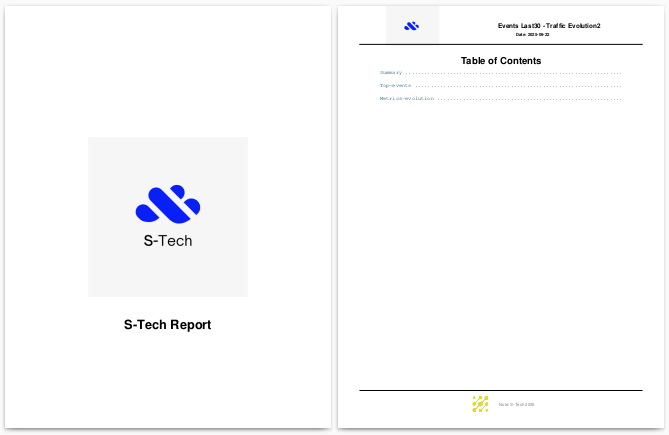
Description
Optional field where the user may include descriptive text relating to the report.
Visibility
In this field, the user will determine whether the report will be visible to other users (i.e., a public report, Public), or whether it will be private and visible only to the report’s creator (Private).
Report type
In this drop-down field the user must select the type of report he/she wishes to create, in this case it will be Top Host.

Note
Depending on the type of report selected, new fields to be defined will be automatically included.
Metrics
Metrics are the different data provided by the Hosts and recorded by WOCU-Monitoring. Each Metric corresponds to a value for a specific time, since these values are collected from time to time.
Thanks to this type of report, it is possible to view the data recorded in WOCU-Monitoring for different metrics in an organized manner. Additionally, you can apply various filters and select complex and very specific time frames, ensuring the generation of completely customized reports.
To select a specific metric, type its name in the Metrics filter. Entering characters will display a list of metrics whose names correspond to the characters entered. The user can select one of the proposed metrics from the list.

Note that when entering certain terms, e.g. “cpu”, “traffic”, “memory”, etc. the system suggests as first choice these terms surrounded by the characters “/.*term.*/” (e.g. /.*cpu.*/). These are the wildcards used by WOCU. These wildcards replace any character before or after the entered term. Following the example, /.*cpu.*/ would show you all the Metrics whose name contains the characters “cpu”, i.e. all those metrics related in some way to the CPUs of the monitored Hosts. In a sense, the use of wildcards allows to perform generic queries on a specific aspect of the Hosts in a quick and easy way. If a more specific metric is required, it will be necessary to search for it through the Metrics stored by WOCU-Monitoring.
Attention
Given the wide variety of Systems and Devices that WOCU-Monitoring is capable of monitoring, a detailed description of the different Metrics that exist exceeds the scope of this manual, since the Metrics available to you in this option will always depend on the type of elements monitored.
Function
The function is a filter that models the displayed information according to four criteria selectable through the drop-down menu.

Maximum peak (MAX - peak)
Selecting this option will display the maximum value during the selected time frame(s).
Minimum peak (MIN - peak)
Selecting this option will display the minimum value during the selected time frame(s).
Maximum mean (MAX - mean)
Selecting this option will display the maximum average value during the selected time frame(s).
Minimum mean (MIN - mean)
Selecting this option will display the minimum average value during the selected time frame(s).
Records
This option allows you to select via the drop-down menu the number of records to be displayed in the report. It is possible to select a limited number of results (10, 50, 100, 250 or 500 records) or an unlimited number.

Units
The metrics are given in units and by default WOCU-Monitoring displays them as they were recorded, but through the Unit field, the user can change and model the unit type of the values obtained for the established metric, according to five selectable criteria through the drop-down menu.

The options for changing metric units are as follows:
Original Values
This option displays the raw Metric value, as recorded by WOCU-Monitoring.
Bits per second to Kilobits per second (bps to Kbps)
This option expresses the value of the Metric in Kilobits per second. This option is useful when the Original Value is an amount of traffic expressed in bits per second. From certain traffic volumes onwards, it is not practical to look at very large amounts in bps and it is more convenient for the user to use a larger magnitude such as Kbps.
Bits per second to Megabits per second (bps to Mbps)
This option expresses the value of the Metric in Megabits per second. This option is useful when the Original Value is an amount of traffic expressed in bits per second. With large data volumes an even larger magnitude than Kbps is required and in these cases expressing the value in Mbps is much more convenient and practical.
MegaBytes to Gigabytes (MB to GB)
This option expresses the value of the Metric in Gigabytes. This option is useful when the Original Value is a quantity of data (usually memory or disk) expressed in Megabytes. From certain volumes of data it is not practical to look at very large amounts in MB and it is more convenient for the user to use a larger magnitude such as GB.
Megabytes to Terabytes (MB to TB)
This option expresses the value of the Metric in Terabytes. This option is useful when the Original Value is an amount of data (usually memory or disk) expressed in MegaBytes. With large volumes of data an even larger magnitude than MB is required and in these cases expressing the value in TB is much more convenient and practical.
Percentage (%)
This option expresses the value of the metric in percent. There are metrics with percentage values (e.g. CPU usage) for which this option is the most appropriate.
WOCU-Monitoring allows you to set two metrics in a single report using the Add Metric button. Clicking it will open a new row of parameters that you need to configure. If you want to delete one of them, just click the button with the cross (x) and the set of fields will disappear.

Host Groups
This configuration parameter allows filtering of the data collected and reflected in the report, showing only those datarelating to the Host Group existing in WOCU-Monitoring.

To select and filter the results of the report by a specific Host Group, simply choose the name of the group from the Host Group drop-down menu. All the groups registered within the realm will be displayed.
To deactivate the filter, the user must choose the No HG filter option, which appears first in the list.
To save the configuration and generate the report, click on the blue Create.

Once the report has been created and scheduled, you will be taken back to the initial screen of this section, where the reports will be sequentially stacked in the Centralized Report Management.

Click on the Name to access the full report. The user is then taken to a new report window where the information generated and collected by the system is presented. These panels are described in detail in the next section.

Configuración de un informe múltiple
WOCU-Monitoring allows the creation of multiple reports in a single operation. This allows the user to define several reports of different types from a single configuration form.
The operation is simple and intuitive. Once the user selects the first report, the system enables the + button in the upper right corner of the configuration form. Clicking this button displays a new form for defining another report.
Attention
The system supports the combination of the seven types of reports available, as long as they are of different types.
If a report is to be deleted, the user can use the x button, which deletes the previously configured settings.

Each configuration form includes a Hide Report Config button (identified by an eye icon with a diagonal line through it), which allows you to hide the corresponding configuration view and expand the available screen space.
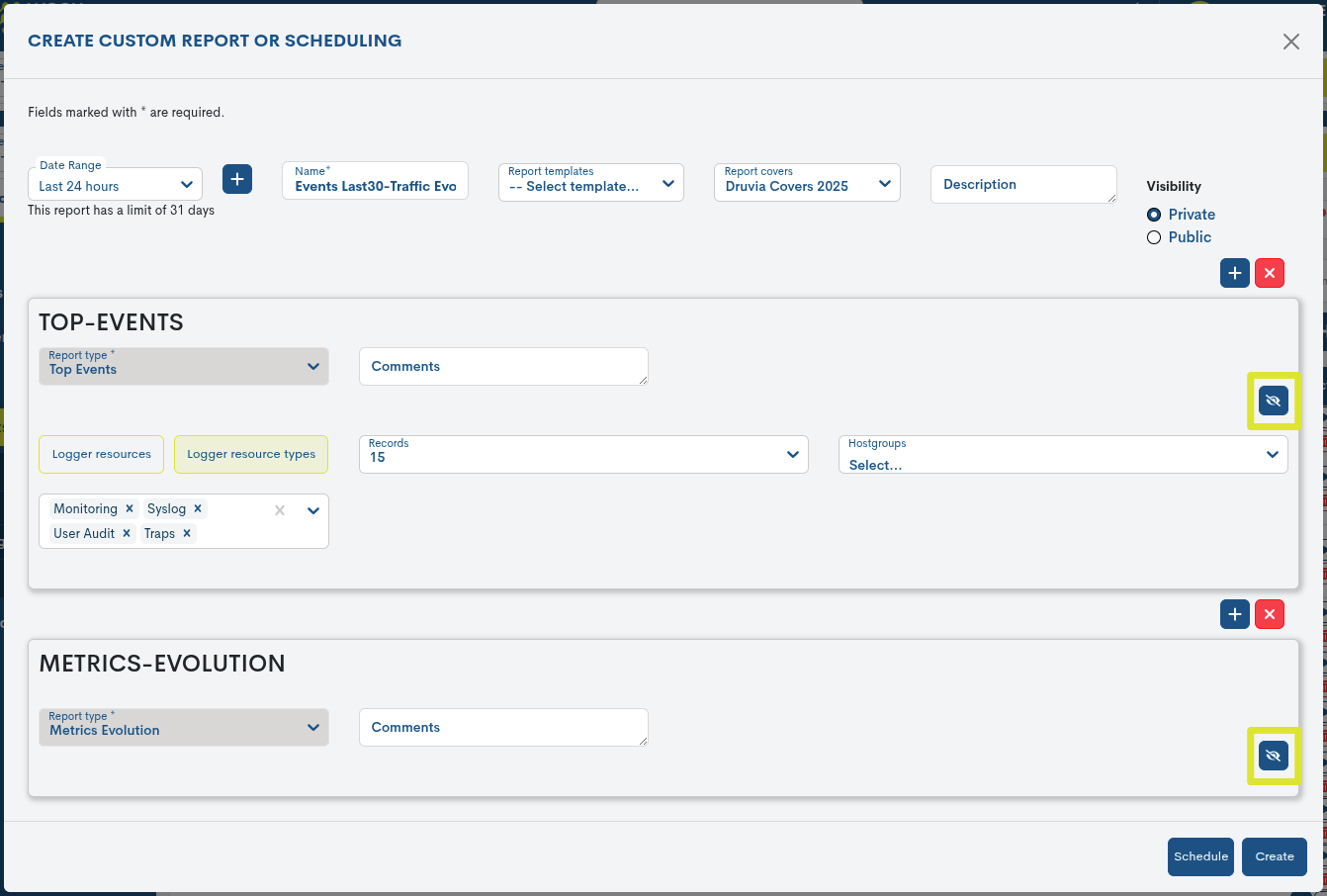
See the following multiple report structured in two separate sections:
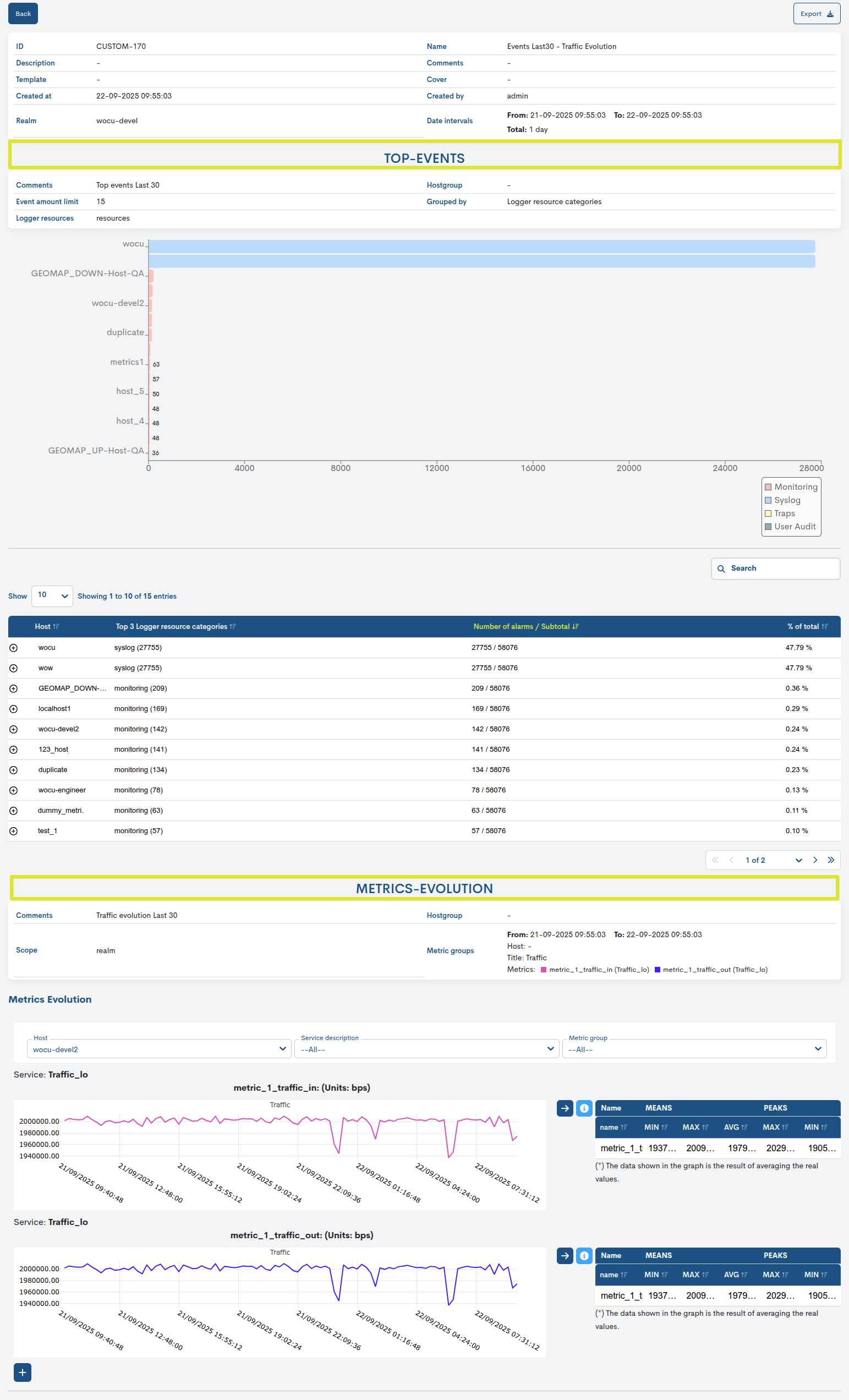
Scheduling the Most Relevant Device Reports
WOCU-Monitoring also allows for the automation of reporting operations, thanks to the ability to schedule their generation and launch at the user’s discretion using the Schedule button.

Next, a form will appear to begin setting up your schedule. For more information, see the following section: Schedule.
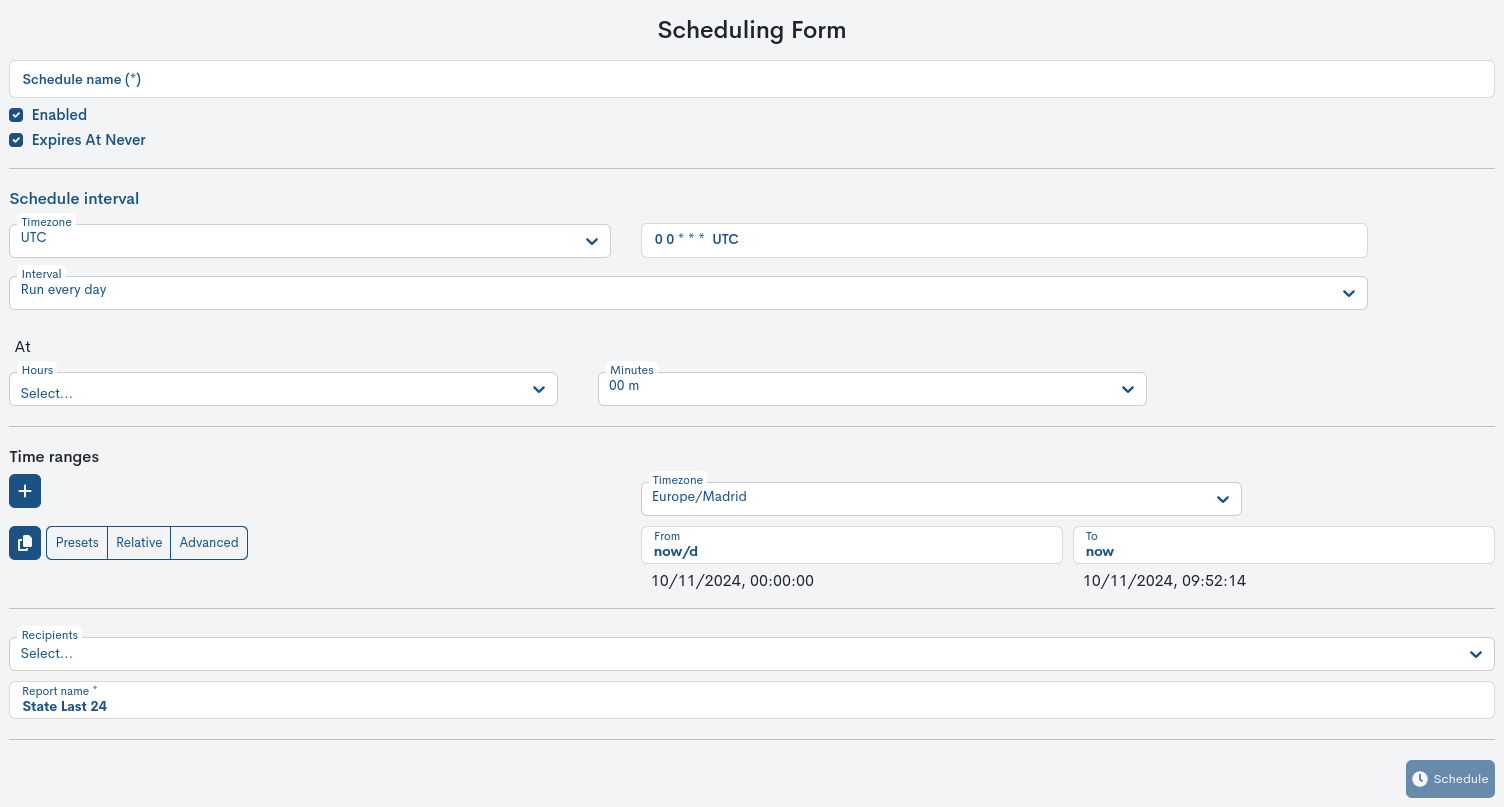
Exporting Top Host Reports
WOCU-Monitoring also allows the report to be exported in PDF, XLSX, and JSON formats. These condense all the information on the availability of the monitored assets into a document that is easy to distribute and analyze.
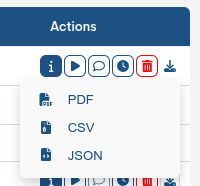
Through the Export selector located in the global report panel, the corresponding files shall be downloaded.
Important
WOCU-Monitoring will return an error message when the report scope exceeds a certain number of devices. The default number is 1,000 devices, but this number may vary depending on the environment and infrastructure being monitored.
Viewing and analyzing the Top Hosts reports
Clicking on the name label (column Name) takes you to the full report.
The report information is presented through interactive dashboards and graphs, designed to facilitate user interpretation.

Each report panel will present color-coded value graphs to improve readability and data recognition. Additionally, a description of the parameters and filters used in the report will be included.

From left to right:
Firstly, the Metrics applied (larger and bold text).
In brackets: Function applied and Number of Records.
Placing the cursor over the text will display a description of the filters applied in a short line of explanatory text:

Settings panels
The filters and parameters established in the configuration of the generated report are presented in a tabular format.

These are
ID: report identifier code.
Description: descriptive text relating to the report.
Template: Templates selected on which the report is based.
Create at: indicates the date and time the report was created.
Realm: Indicates the name of the Realm which is the subject of the report.
Name: identification name assigned to the report.
Comments: Free text assigned by the user regarding observations, annotations, or additional clarifications regarding the report.
Cover: Specifies the Covers applied to the report.
Create by: indicates the user who created/owns the report.
Date intervals: indicates the time and date of the start and end of the period.
In multiple time frames, periods will be presented in a tabular format. The total range limit is 31 days.

Comments: Free text assigned by the user regarding observations, annotations, or additional clarifications regarding the report.
Metrics: Includes summary information on the metrics used in generating the report. Each row represents a configured metric, with the following fields:
Metric: Each row records a metric selected for the report calculation.
Function: Specifies the mathematical function applied to the metric.
Records: Specifies the number of records considered for the metric.
Units: indicates the unit in which the values are expressed.
Hostgroup: Specifies the device group selected for the report calculation.
Top active panels by metric
For each metric selected in the report, a detailed table is generated showing the monitored assets that meet the criteria defined in the query for that metric.

This panel has the fields described below:
Host
This field includes the name of the device from which the selected metric values are displayed.
Clicking on a specific device’s name will display its corresponding detail view with the configuration values registered in the system.
Metric
This field indicates which metrics WOCU-Monitoring collects for a given device and uses for analysis.
Note
This field will display the Metric(s) selected in the filter Metrics described above. This field is especially useful when using wildcards in the filter, which allow related metrics to be displayed at the same time, since this field allows the user to identify the specific type of metric displayed.
Service
This field indicates which Service of a Host the report refers to for the selected metric.

Note
This field makes it much easier for the user to understand and analyze the data displayed by WOCU-Monitoring. A Service can have several metrics, in the example, the R1-bgp.a3sec.com Host, on its port Traffic_FastEthernet1/0 (Service field) has two different metrics: incoming traffic (metric_1_traffic_in) and outgoing traffic (metric_1_traffic_out). This field makes it easier to establish the relationship between the different metrics displayed for one or more of the Services of a Host.
Time
This field reports the time or period of time when a Host Metric has reached a certain Value.
The use of the Peaks (Maximum or Minimum) functions is reflected in the Date (Time) field, as the time at which the most extreme value for that metric was recorded is displayed.
In the case of the Averages functions (Maximum or Minimum), the Date (Time) field shall indicate the period over which the calculation of the average has been performed.
Value
This field displays the unit type of the values obtained for a device’s metric, within the selected time frame and according to the configured function.
Using the drop-down menu, you can change the magnitudes in which this value is expressed.
In addition, WOCU-Monitoring will display a bar that graphically represents the values of each Metric. This element allows to visually compare the values of different Hosts.
The options for changing the magnitude of the Metric value are as follows:

Original Values
This option displays the raw Metric value, as recorded by WOCU-Monitoring.
Bits per second to Kilobits per second (bps to Kbps)
This option expresses the value of the Metric in Kilobits per second. This option is useful when the Original Value is an amount of traffic expressed in bits per second. From certain traffic volumes onwards, it is not practical to look at very large amounts in bps and it is more convenient for the user to use a larger magnitude such as Kbps.
Bits per second to Megabits per second (bps to Mbps)
This option expresses the value of the Metric in Megabits per second. This option is useful when the Original Value is an amount of traffic expressed in bits per second. With large data volumes an even larger magnitude than Kbps is required and in these cases expressing the value in Mbps is much more convenient and practical.
Bits per second to Gigabits per second (bps to Gbps)
This option expresses the Metric value in Gigabits per second. It is useful when the original value is an amount of traffic expressed in bits per second. Large data volumes require a value greater than Mbps. In these cases, it is recommended to express the value in Gbps.
Bits per second to Terabits per second (bps to Tbps)
This option expresses the Metric value in Terabits per second. It is useful when the Original Value is an amount of traffic expressed in bits per second. Large data volumes require a magnitude greater than Gbps. In these cases, it is recommended to express the value in Tbps.
MegaBytes to Gigabytes (MB to GB)
This option expresses the value of the Metric in Gigabytes. This option is useful when the Original Value is a quantity of data (usually memory or disk) expressed in Megabytes. From certain volumes of data it is not practical to look at very large amounts in MB and it is more convenient for the user to use a larger magnitude such as GB.
Megabytes to Terabytes (MB to TB)
This option expresses the value of the Metric in Terabytes. This option is useful when the Original Value is an amount of data (usually memory or disk) expressed in MegaBytes. With large volumes of data an even larger magnitude than MB is required and in these cases expressing the value in TB is much more convenient and practical.
Percentage (%)
This option expresses the value of the metric in percent. There are metrics with percentage values (e.g. CPU usage) for which this option is the most appropriate.
Comments
Free text field to add comments, notes, or additional clarifications about the report.